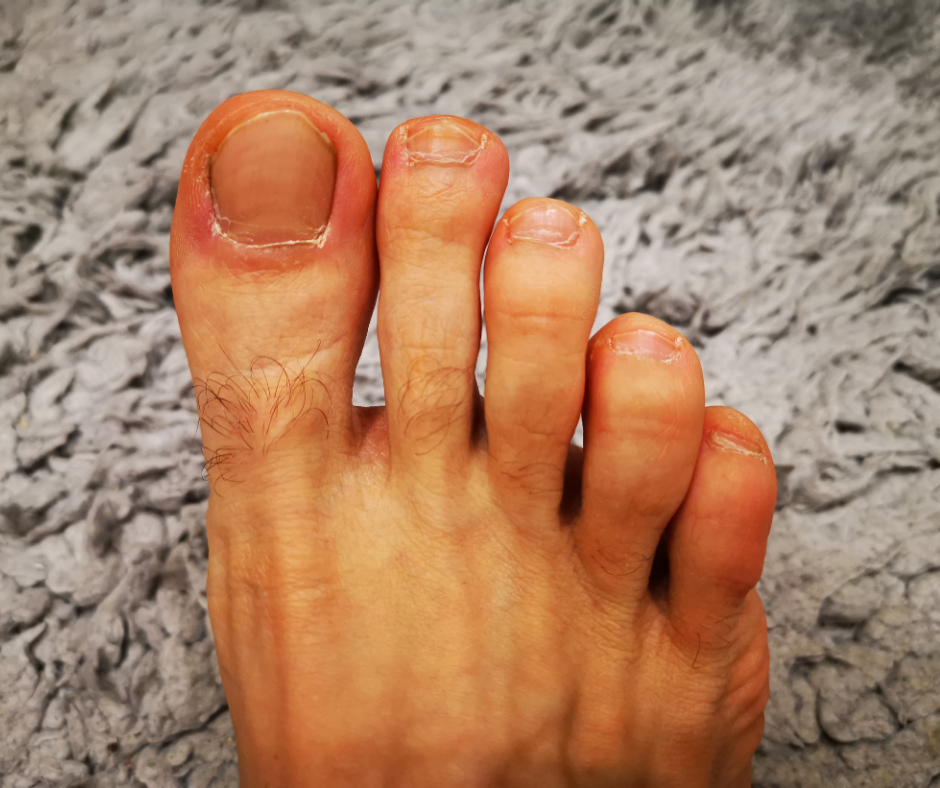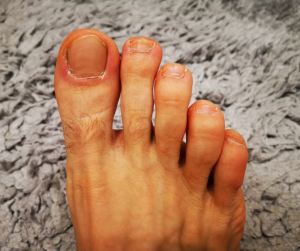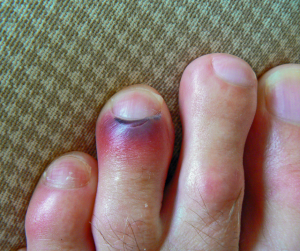
 Having our toes suddenly turn red can be alarming – especially when we can’t pinpoint a specific cause. Alongside the redness, you may also experience some pain, swelling, and wearing your regular work shoes or joggers may now feel uncomfortable. As the cause of the redness can range from problems with our skin and blood vessels to problems with our muscles and bones, our podiatry team has shared the top five causes of red toes that we see and treat here at My FootDr.
Having our toes suddenly turn red can be alarming – especially when we can’t pinpoint a specific cause. Alongside the redness, you may also experience some pain, swelling, and wearing your regular work shoes or joggers may now feel uncomfortable. As the cause of the redness can range from problems with our skin and blood vessels to problems with our muscles and bones, our podiatry team has shared the top five causes of red toes that we see and treat here at My FootDr.
1. Chilblains
 Chilblains, or perniosis, appear as red patches on skin, often at the tips of the toes. They develop after exposing your feet to very cold temperatures, like during skiing or leaving your feet in wet boots, and then quickly warming them by putting them in a warm shower, placing them in front of the heater, and so on.
Chilblains, or perniosis, appear as red patches on skin, often at the tips of the toes. They develop after exposing your feet to very cold temperatures, like during skiing or leaving your feet in wet boots, and then quickly warming them by putting them in a warm shower, placing them in front of the heater, and so on.
As our blood vessels narrow when we’re cold and dilate when we’re warm, it is the rapid widening of the blood vessels in the toes and the sudden rush of blood (and the increased pressure) when the feet are suddenly exposed to the warm temperatures that causes the damage to the blood vessel walls. This results in blood leaking out into the surrounding tissues and causing the redness, swelling and discomfort. Your toes may also feel itchy and you may get some blistering, with the colour of the toes changing to a purple-blue over time.
Preventing chilblains is as simple as making sure to gradually warm your toes after they’ve been exposed to the cold. This can be done by letting them sit at room temperature for 20 minutes before jumping into the warm shower, or putting socks on to help gradually warm the feet before putting them by the warm fire. Once you have chilblains, it’s a waiting game for the redness and discomfort to subside, which can take weeks.
If you do get any blistering or breaks in the skin then keep an eye out for infection – and if one develops, or your pain becomes severe, see your podiatrist.
2. Athlete’s Foot
Athlete’s foot, otherwise known as tinea pedis, is a fungal foot infection that usually starts between the toes, affecting the tops of the toes and the bottom of the foot. Despite the name, you don’t need to be an athlete to get this problem – though it is more common among athletes, especially those in water-based sports as fungus thrives in moist and warm conditions. This makes us here in Australia particularly vulnerable, with our climate leading to many of us spending our days with warm, sweaty feet in our enclosed work boots or sports shoes.
Aside from redness, those suffering from Athlete’s foot can also experience itchiness, bubbles in the skin which can peel, and tenderness if the skin gets irritated.
To help Athlete’s foot, keep your feet clean and dry, give your feet time to breathe, air your closed-in shoes daily, and wear socks that wick moisture away from your feet. Here at My FootDr, we have a range of antifungal creams to help treat Athlete’s foot – before it spreads to others in your household.
3. Contact Dermatitis
Contact dermatitis describes skin inflammation that is caused by direct contact with an irritant or an allergen. Unlike Athlete’s foot, it’s not caused by an infectious microorganism like fungus, bacteria or yeast – but rather by chemicals, soaps, detergents or allergens like metals, plants, cosmetics and the like.
Alongside the redness across the toes and any other areas that come in contact with the allergens, you may also experience skin tenderness, dryness, itching, burning and rashes that can break the skin and make you vulnerable to infection.
Treating contact dermatitis involves identifying the source of the irritation and avoiding direct contact. Wearing socks and enclosed shoes that don’t expose the toes at work is a great start, especially if you work anywhere where you may be exposed to skin products, detergents and cleaning/disinfection products.
Your GP may be able to prescribe medication to help manage your symptoms, while our podiatry team helps patients reduce their risk of infection, confirming their diagnosis, and ruling out other causes of toe redness and pain.
4. Injuries To The Toes
Any time our toes are injured or there is damage to our skin, our skin can become red and swollen as blood rushes to the area and our healing & repair response is activated. The most common injuries to the toes we see are from:
- Friction – rubbing against the toes, often by the shoes
- Stubbing the toes and bruising them
- Ingrown toenails – this redness will be isolated to the sides of the toenails and will likely have some swelling too
- Impact during kicking sports like soccer
- Toe fractures – broken toes
Toe pain resulting from friction and pressure can be managed by avoiding the footwear that is causing the problem, and staying mindful of problems like hammertoes and claw toes, as well as long second toes, where the joints of the toes are prominent and make rubbing, corns and callus a higher risk.
If you are also experiencing pain and swelling and suspect you have a toe injury, it’s important to have it seen, diagnosed and treated by your podiatrist so you can continue to walk without worsening the injury and prolonging your recovery time.
5. Arthritis
There are two types of arthritis we see that most often cause redness in the toes: gout and rheumatoid arthritis.
Gout is a type of inflammatory arthritis that is caused by the build-up of uric acid in the joints of the feet. It causes pain, redness and significant swelling in the joints during flares that can make walking and any pressure extremely uncomfortable. While gout most commonly affects the big toe joint, it can affect any of the joints in the toes, bringing on the redness and symptoms.
Rheumatoid arthritis is an auto-immune disease where the body’s own cells attack the lining of the joints, causing pain, swelling and redness. Rheumatoid arthritis often affects the joints of the hands and feet, often affecting the lesser toe joints. Over time, the ongoing joint damage can cause changes to the structure and appearance of the joints in some people, with the toes starting to face outwards at an angle.
Here at My FootDr, we work extensively to improve the comfort and mobility for those affected by arthritis. This includes using padding and orthotics to relieve pressure away from painful joints, which can make walking more comfortable while helping to prevent or slow further joint deterioration anddamage.
Unsure what’s causing the redness in your toes?
That’s where our experienced podiatry team comes in. We ensure you have the right diagnosis, so you know how to best treat and care for your feet now – and prevent the problem from recurring in the future. Book your appointment with our experienced podiatry team by calling us on 1800 FOOT DR or book your appointment online.


